fuel type VOLVO XC90 TWIN ENGINE HYBRID 2017 Owners Manual
[x] Cancel search | Manufacturer: VOLVO, Model Year: 2017, Model line: XC90 TWIN ENGINE HYBRID, Model: VOLVO XC90 TWIN ENGINE HYBRID 2017Pages: 584, PDF Size: 14.2 MB
Page 136 of 584

||
INSTRUMENTS AND CONTROLS
134
Related information
•Instrument panel App menu (p. 160)
•Warning symbols in the instrument panel(p. 141)
•Indicator symbols in the instrument panel(p. 130)
•Instrument panel licenses (p. 136)
Hybrid-related information in theinstrument panel
Different types of information will be displayed inthe instrument panel, depending on the drivemode selected. These drive modes offer uniqueways of helping the driver achieve the best pos-sible driving economy.
The vehicle also stores driving statistics that canbe viewed in the form of a bar graph.
Hybrid-unique symbols
The various gauges and indicators in the instru-ment panel show the relationship between theelectric motor's current power consumption andthe remaining power available.
Indicates the currently available outputfrom the electric motor. A solid symbolindicates that the electric motor isbeing used.
Indicates the currently available outputfrom the electric motor. A hollow sym-bol means that the electric motor isnot being used.
Indicates the output level when thegasoline engine starts. A solid symbolindicates that the gasoline engine isbeing used.
Indicates the output level when thegasoline engine will start. A hollowsymbol indicates that the gasolineengine is not being used.
Indicates that the hybrid battery isbeing charged.
Indicates the current charge level inthe electric motor's battery. This indica-tor is located by the hybrid batterygauge in the lower right corner.
eDTE (Electrical Distance To Empty)indicator (distance until the hybrid bat-tery is discharged).
The hybrid gauge
Available electric motor output
This hybrid battery indicator is located betweenthe hybrid gauge and the fuel gauge on the lowerright side of the instrument panel. It indicates thecurrent (charge level) remaining in the hybrid bat-tery, which can be used to power the electricmotor or to heat/cool the vehicle.
Page 390 of 584
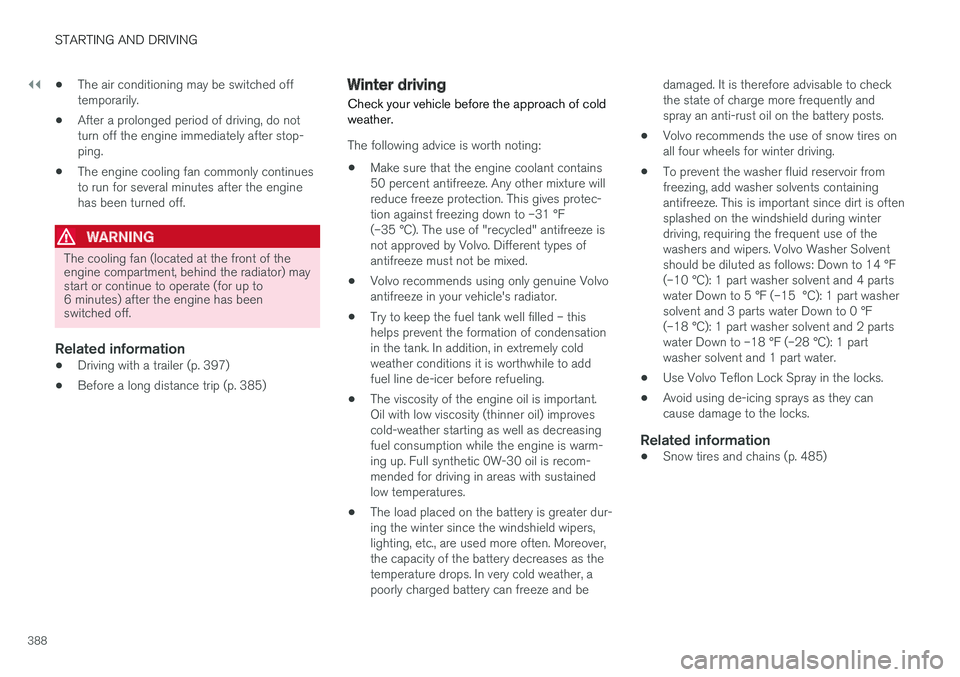
||
STARTING AND DRIVING
388
•The air conditioning may be switched offtemporarily.
•After a prolonged period of driving, do notturn off the engine immediately after stop-ping.
•The engine cooling fan commonly continuesto run for several minutes after the enginehas been turned off.
WARNING
The cooling fan (located at the front of theengine compartment, behind the radiator) maystart or continue to operate (for up to6 minutes) after the engine has beenswitched off.
Related information
•Driving with a trailer (p. 397)
•Before a long distance trip (p. 385)
Winter driving
Check your vehicle before the approach of coldweather.
The following advice is worth noting:
•Make sure that the engine coolant contains50 percent antifreeze. Any other mixture willreduce freeze protection. This gives protec-tion against freezing down to –31 °F(–35 °C). The use of "recycled" antifreeze isnot approved by Volvo. Different types ofantifreeze must not be mixed.
•Volvo recommends using only genuine Volvoantifreeze in your vehicle's radiator.
•Try to keep the fuel tank well filled – thishelps prevent the formation of condensationin the tank. In addition, in extremely coldweather conditions it is worthwhile to addfuel line de-icer before refueling.
•The viscosity of the engine oil is important.Oil with low viscosity (thinner oil) improvescold-weather starting as well as decreasingfuel consumption while the engine is warm-ing up. Full synthetic 0W-30 oil is recom-mended for driving in areas with sustainedlow temperatures.
•The load placed on the battery is greater dur-ing the winter since the windshield wipers,lighting, etc., are used more often. Moreover,the capacity of the battery decreases as thetemperature drops. In very cold weather, apoorly charged battery can freeze and be
damaged. It is therefore advisable to checkthe state of charge more frequently andspray an anti-rust oil on the battery posts.
•Volvo recommends the use of snow tires onall four wheels for winter driving.
•To prevent the washer fluid reservoir fromfreezing, add washer solvents containingantifreeze. This is important since dirt is oftensplashed on the windshield during winterdriving, requiring the frequent use of thewashers and wipers. Volvo Washer Solventshould be diluted as follows: Down to 14 °F(–10 °C): 1 part washer solvent and 4 partswater Down to 5 °F (–15 °C): 1 part washersolvent and 3 parts water Down to 0 °F(–18 °C): 1 part washer solvent and 2 partswater Down to –18 °F (–28 °C): 1 partwasher solvent and 1 part water.
•Use Volvo Teflon Lock Spray in the locks.
•Avoid using de-icing sprays as they cancause damage to the locks.
Related information
•Snow tires and chains (p. 485)
Page 448 of 584
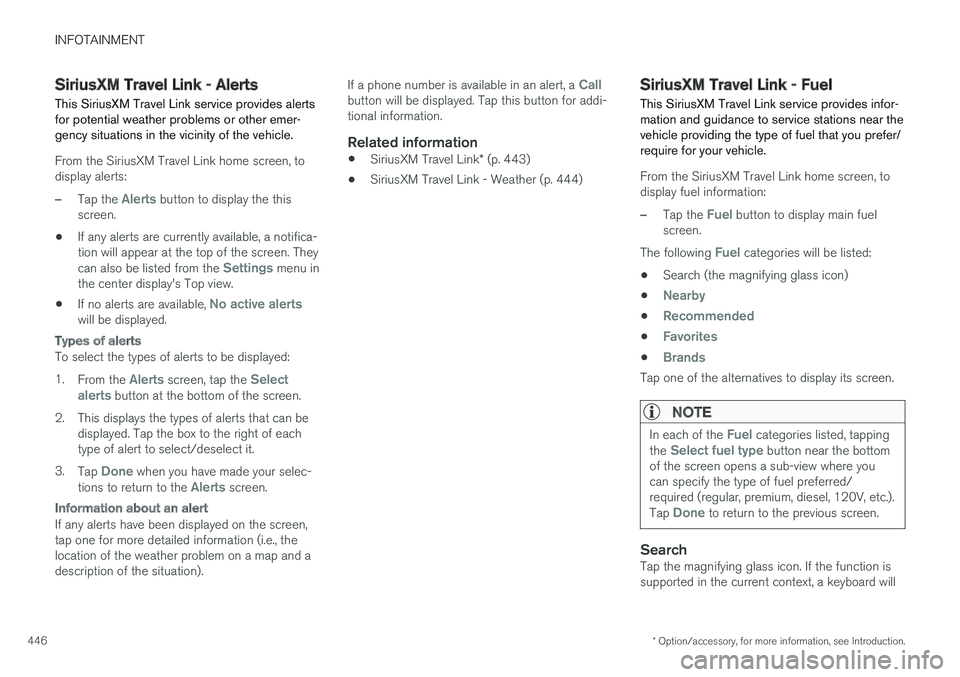
INFOTAINMENT
* Option/accessory, for more information, see Introduction.446
SiriusXM Travel Link - Alerts
This SiriusXM Travel Link service provides alertsfor potential weather problems or other emer-gency situations in the vicinity of the vehicle.
From the SiriusXM Travel Link home screen, todisplay alerts:
–Tap the Alerts button to display the thisscreen.
•If any alerts are currently available, a notifica-tion will appear at the top of the screen. Theycan also be listed from the Settings menu inthe center display's Top view.
•If no alerts are available, No active alertswill be displayed.
Types of alerts
To select the types of alerts to be displayed:
1.From the Alerts screen, tap the Selectalerts button at the bottom of the screen.
2.This displays the types of alerts that can bedisplayed. Tap the box to the right of eachtype of alert to select/deselect it.
3.Tap Done when you have made your selec-tions to return to the Alerts screen.
Information about an alert
If any alerts have been displayed on the screen,tap one for more detailed information (i.e., thelocation of the weather problem on a map and adescription of the situation).
If a phone number is available in an alert, a Callbutton will be displayed. Tap this button for addi-tional information.
Related information
•SiriusXM Travel Link* (p. 443)
•SiriusXM Travel Link - Weather (p. 444)
SiriusXM Travel Link - Fuel
This SiriusXM Travel Link service provides infor-mation and guidance to service stations near thevehicle providing the type of fuel that you prefer/require for your vehicle.
From the SiriusXM Travel Link home screen, todisplay fuel information:
–Tap the Fuel button to display main fuelscreen.
The following Fuel categories will be listed:
•Search (the magnifying glass icon)
•Nearby
•Recommended
•Favorites
•Brands
Tap one of the alternatives to display its screen.
NOTE
In each of the Fuel categories listed, tappingthe Select fuel type button near the bottomof the screen opens a sub-view where youcan specify the type of fuel preferred/required (regular, premium, diesel, 120V, etc.).Tap Done to return to the previous screen.
Search
Tap the magnifying glass icon. If the function issupported in the current context, a keyboard will
Page 449 of 584
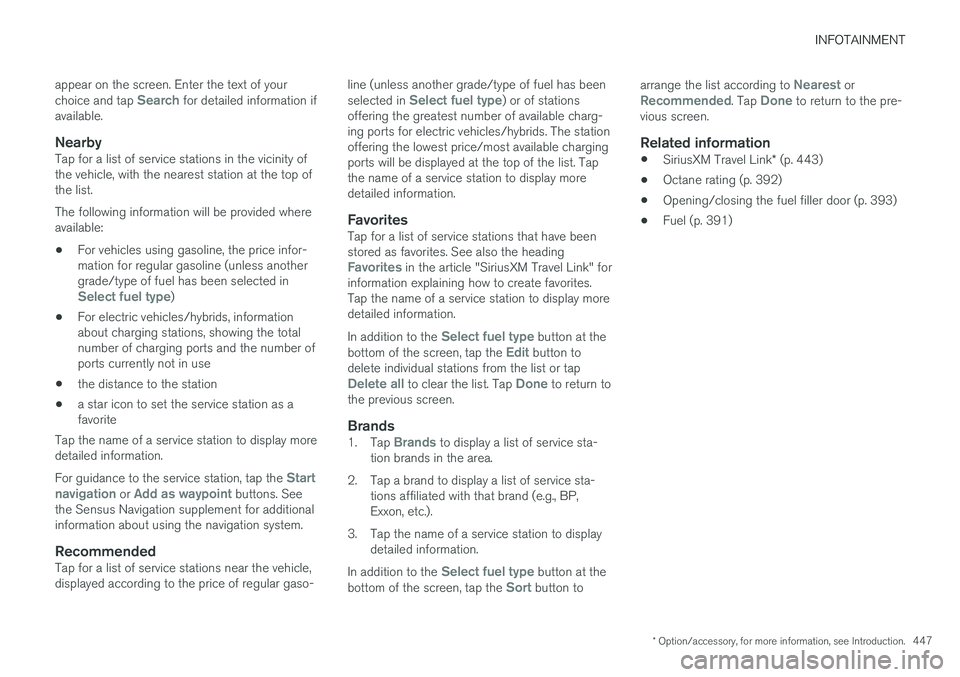
INFOTAINMENT
* Option/accessory, for more information, see Introduction.447
appear on the screen. Enter the text of yourchoice and tap Search for detailed information ifavailable.
Nearby
Tap for a list of service stations in the vicinity ofthe vehicle, with the nearest station at the top ofthe list.
The following information will be provided whereavailable:
•For vehicles using gasoline, the price infor-mation for regular gasoline (unless anothergrade/type of fuel has been selected inSelect fuel type)
•For electric vehicles/hybrids, informationabout charging stations, showing the totalnumber of charging ports and the number ofports currently not in use
•the distance to the station
•a star icon to set the service station as afavorite
Tap the name of a service station to display moredetailed information.
For guidance to the service station, tap the Startnavigation or Add as waypoint buttons. Seethe Sensus Navigation supplement for additionalinformation about using the navigation system.
Recommended
Tap for a list of service stations near the vehicle,displayed according to the price of regular gaso-
line (unless another grade/type of fuel has beenselected in Select fuel type) or of stationsoffering the greatest number of available charg-ing ports for electric vehicles/hybrids. The stationoffering the lowest price/most available chargingports will be displayed at the top of the list. Tapthe name of a service station to display moredetailed information.
Favorites
Tap for a list of service stations that have beenstored as favorites. See also the headingFavorites in the article "SiriusXM Travel Link" forinformation explaining how to create favorites.Tap the name of a service station to display moredetailed information.
In addition to the Select fuel type button at thebottom of the screen, tap the Edit button todelete individual stations from the list or tapDelete all to clear the list. Tap Done to return tothe previous screen.
Brands
1.Tap Brands to display a list of service sta-tion brands in the area.
2.Tap a brand to display a list of service sta-tions affiliated with that brand (e.g., BP,Exxon, etc.).
3. Tap the name of a service station to displaydetailed information.
In addition to the Select fuel type button at thebottom of the screen, tap the Sort button to
arrange the list according to Nearest orRecommended. Tap Done to return to the pre-vious screen.
Related information
•SiriusXM Travel Link* (p. 443)
•Octane rating (p. 392)
•Opening/closing the fuel filler door (p. 393)
•Fuel (p. 391)
Page 507 of 584
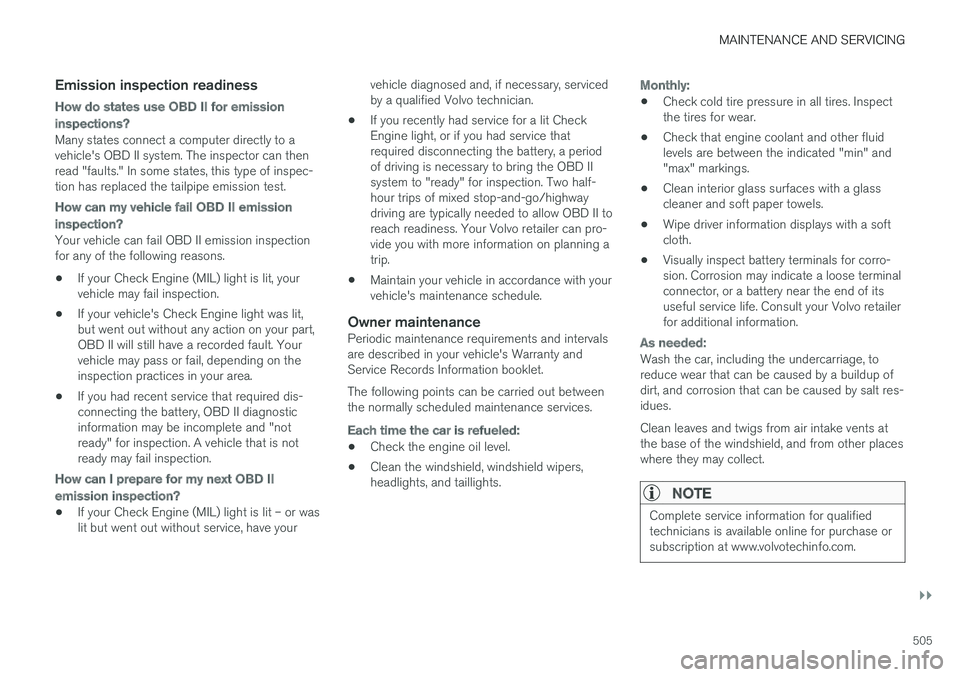
MAINTENANCE AND SERVICING
}}
505
Emission inspection readiness
How do states use OBD II for emission
inspections?
Many states connect a computer directly to avehicle's OBD II system. The inspector can thenread "faults." In some states, this type of inspec-tion has replaced the tailpipe emission test.
How can my vehicle fail OBD II emission
inspection?
Your vehicle can fail OBD II emission inspectionfor any of the following reasons.
•If your Check Engine (MIL) light is lit, yourvehicle may fail inspection.
•If your vehicle's Check Engine light was lit,but went out without any action on your part,OBD II will still have a recorded fault. Yourvehicle may pass or fail, depending on theinspection practices in your area.
•If you had recent service that required dis-connecting the battery, OBD II diagnosticinformation may be incomplete and "notready" for inspection. A vehicle that is notready may fail inspection.
How can I prepare for my next OBD II
emission inspection?
•If your Check Engine (MIL) light is lit – or waslit but went out without service, have your
vehicle diagnosed and, if necessary, servicedby a qualified Volvo technician.
•If you recently had service for a lit CheckEngine light, or if you had service thatrequired disconnecting the battery, a periodof driving is necessary to bring the OBD IIsystem to "ready" for inspection. Two half-hour trips of mixed stop-and-go/highwaydriving are typically needed to allow OBD II toreach readiness. Your Volvo retailer can pro-vide you with more information on planning atrip.
•Maintain your vehicle in accordance with yourvehicle's maintenance schedule.
Owner maintenance
Periodic maintenance requirements and intervalsare described in your vehicle's Warranty andService Records Information booklet.
The following points can be carried out betweenthe normally scheduled maintenance services.
Each time the car is refueled:
•Check the engine oil level.
•Clean the windshield, windshield wipers,headlights, and taillights.
Monthly:
•Check cold tire pressure in all tires. Inspectthe tires for wear.
•Check that engine coolant and other fluidlevels are between the indicated "min" and"max" markings.
•Clean interior glass surfaces with a glasscleaner and soft paper towels.
•Wipe driver information displays with a softcloth.
•Visually inspect battery terminals for corro-sion. Corrosion may indicate a loose terminalconnector, or a battery near the end of itsuseful service life. Consult your Volvo retailerfor additional information.
As needed:
Wash the car, including the undercarriage, toreduce wear that can be caused by a buildup ofdirt, and corrosion that can be caused by salt res-idues.
Clean leaves and twigs from air intake vents atthe base of the windshield, and from other placeswhere they may collect.
NOTE
Complete service information for qualifiedtechnicians is available online for purchase orsubscription at www.volvotechinfo.com.
Page 567 of 584
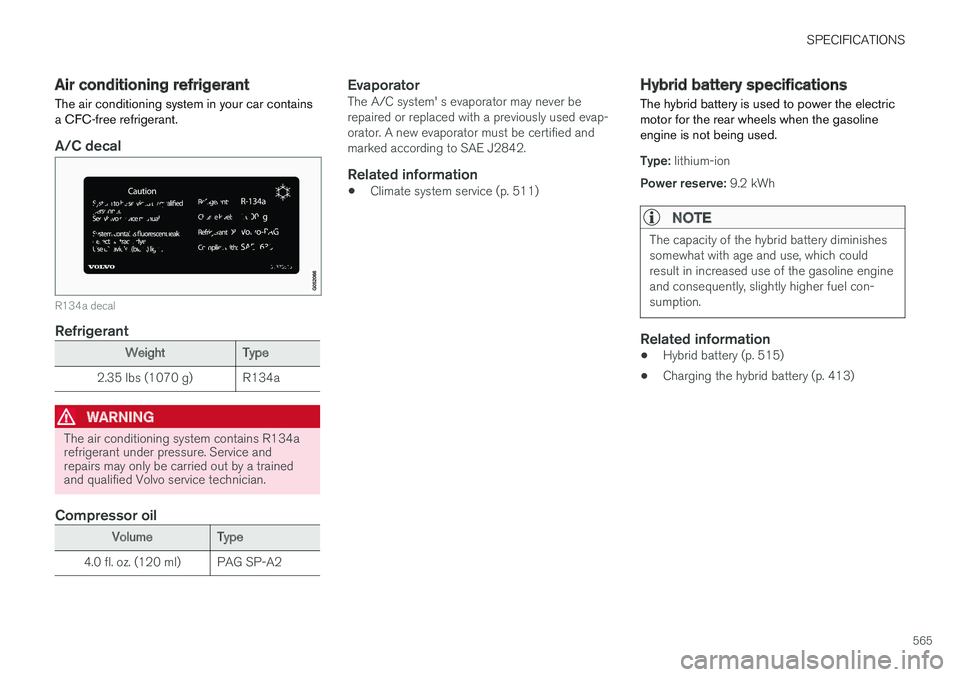
SPECIFICATIONS
565
Air conditioning refrigerant
The air conditioning system in your car containsa CFC-free refrigerant.
A/C decal
R134a decal
Refrigerant
WeightType
2.35 lbs (1070 g)R134a
WARNING
The air conditioning system contains R134arefrigerant under pressure. Service andrepairs may only be carried out by a trainedand qualified Volvo service technician.
Compressor oil
VolumeType
4.0 fl. oz. (120 ml)PAG SP-A2
Evaporator
The A/C system' s evaporator may never berepaired or replaced with a previously used evap-orator. A new evaporator must be certified andmarked according to SAE J2842.
Related information
•Climate system service (p. 511)
Hybrid battery specifications
The hybrid battery is used to power the electricmotor for the rear wheels when the gasolineengine is not being used.
Type: lithium-ion
Power reserve: 9.2 kWh
NOTE
The capacity of the hybrid battery diminishessomewhat with age and use, which couldresult in increased use of the gasoline engineand consequently, slightly higher fuel con-sumption.
Related information
•Hybrid battery (p. 515)
•Charging the hybrid battery (p. 413)
Page 570 of 584
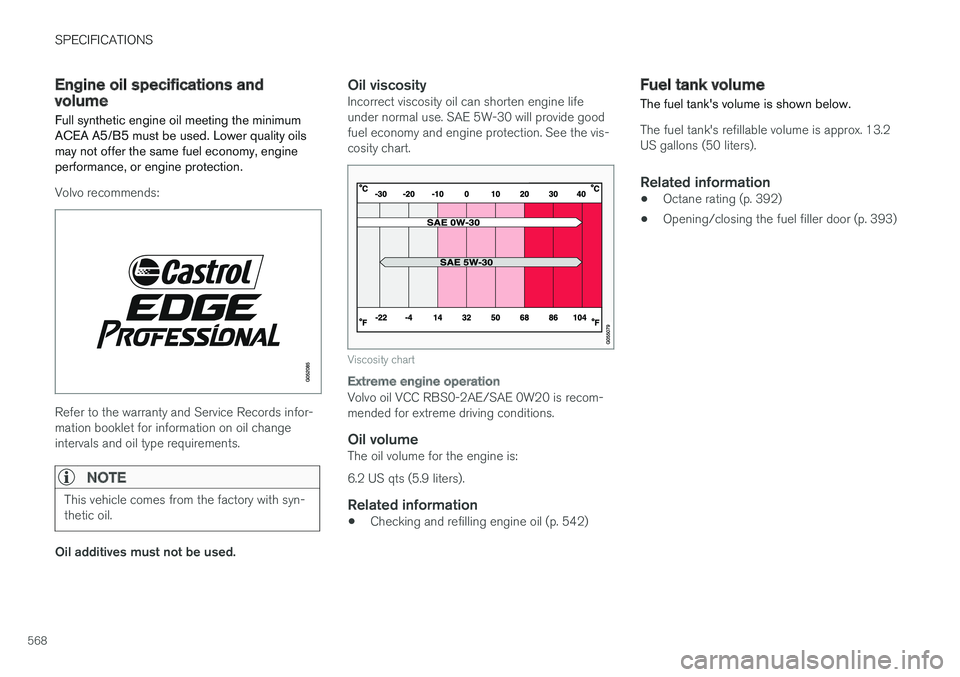
SPECIFICATIONS
568
Engine oil specifications andvolume
Full synthetic engine oil meeting the minimumACEA A5/B5 must be used. Lower quality oilsmay not offer the same fuel economy, engineperformance, or engine protection.
Volvo recommends:
Refer to the warranty and Service Records infor-mation booklet for information on oil changeintervals and oil type requirements.
NOTE
This vehicle comes from the factory with syn-thetic oil.
Oil additives must not be used.
Oil viscosity
Incorrect viscosity oil can shorten engine lifeunder normal use. SAE 5W-30 will provide goodfuel economy and engine protection. See the vis-cosity chart.
Viscosity chart
Extreme engine operation
Volvo oil VCC RBS0-2AE/SAE 0W20 is recom-mended for extreme driving conditions.
Oil volume
The oil volume for the engine is:
6.2 US qts (5.9 liters).
Related information
•Checking and refilling engine oil (p. 542)
Fuel tank volume
The fuel tank's volume is shown below.
The fuel tank's refillable volume is approx. 13.2US gallons (50 liters).
Related information
•Octane rating (p. 392)
•Opening/closing the fuel filler door (p. 393)